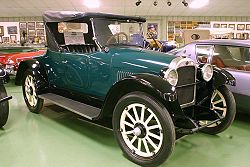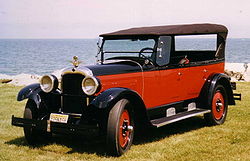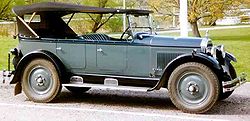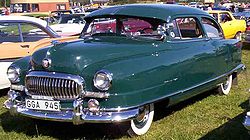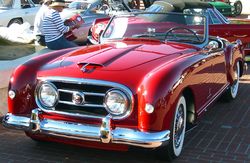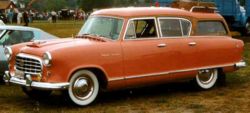- Nash Motors
-
Also see: Kelvinator and American Motors Corporation
Nash Motors 
Industry Automobile Fate Merged Successor Nash-Kelvinator Corporation Founded 1917 Defunct 1954 Headquarters Kenosha, Wisconsin, United States Key people Charles W. Nash, Nils Erik Wahlberg Products Vehicles Nash Motors was an automobile manufacturer based in Kenosha, Wisconsin, in the United States from 1916 to 1938. From 1938 to 1954, Nash was the automotive division of the Nash-Kelvinator Corporation. Nash production continued from 1954 to 1957 after the creation of American Motors Corporation.
Nash pioneered unitary construction (1941), also a heating and ventilation system whose operating principles are now universally utilized (1938), seat belts (1950) and the manufacture of cars in the compact (1950), subcompact (1970) and muscle car (1957) categories.[1]
Contents
History
Nash Motors was founded in 1916 by former General Motors president Charles W. Nash who acquired the Thomas B. Jeffery Company. Jeffery's best-known automobile was the Rambler whose mass production from a plant in Kenosha, Wisconsin began in 1902.
The 1917 Nash Model 671 was the first vehicle produced to bear the name of the new company's founder.[2] Nash enjoyed decades of success by focusing its efforts to build cars "embodying honest worth ... [at] a price level which held out possibilities of a very wide market."[3]
The four-wheel drive Jeffrey Quad truck became an important product for Nash. Approximately 11,500 Quads were built between 1913 and 1919. They served to move material during World War I under severe conditions. The Quad used Meuhl differentials[4] with half-shafts mounted above the load-bearing dead axles to drive the hubs through hub-reduction gearing.[5] in addition to featuring four-wheel steering.[6] The Quad achieved the reputation of being the best four-wheel drive truck produced in the country.[7] The newly formed Nash Motors became the largest producer of four-wheel drives.[8] By 1918, capacity constraints at Nash meant the Paige-Detroit Motor Car Company began to assemble the Nash Quad under license and Nash patents.[9] Nash became the leading producer of military trucks by the end of World War I.[10] After the war ended, surplus Quads were used as heavy work trucks in fields such as construction and logging.[11]
Charles Nash convinced the chief engineer of GM's Oakland Division, Finnish-born Nils Eric Wahlberg, to moving to Nash's new company.[12] The first Nash engine introduced in 1917 by Wahlberg had overhead valves, and Nash incorporated this principle [13] Wahlberg is also credited with helping to design flow-through ventilation that is used today in nearly every motor vehicle. Introduced in 1938, Nash's Weather Eye directed fresh, outside air into the car's fan-boosted, filtered ventilation system, where it was warmed (or cooled), and then removed through rearward placed vents.[14] The process also helped to reduce humidity and equalize the slight pressure differential between the outside and inside of a moving vehicle. Another unique feature of Nash cars was the unequal wheel tracks. The front wheels were set slightly narrower than the rear, thus adding stability and improving cornering. Wahlberg was also an early proponent of wind tunnel testing for vehicles and during World War II worked with Theodore (Ted) Ulrich in the development of Nash's radically styled Airflyte models.[15]
Nash's slogan from the late 1920s and 1930s was "Give the customer more than he has paid for" and the cars lived up to it. Innovations included a straight-eight engine with overhead valves, twin spark plugs, and nine crankshaft bearings in 1930. The 1932 Ambassador Eight had synchromesh transmissions and free wheeling, automatic centralized chassis lubrication, a worm-drive rear end, and its suspension was adjustable inside the car.
The Nash was a success among consumers that meant for the company "selling for a long time has been 100% a production problem... month after month all the cars that could be produced were sold before they left the factory floor."[3]
Creation of the Ajax
For the 1925 model year, Nash introduced the entry-level marque Ajax. A car of exceptional quality for its price, the Ajax was produced in the newly acquired Mitchell Motor Car Company plant in Racine, Wisconsin. Mitchell was the manufacturer of Mitchell-brand automobiles between 1903-1923. Sales of Ajax automobiles, while quite respectable, were disappointing. It was believed that the same car would sell better if it were called a Nash. Thus the Ajax became the "Nash Light Six" in June, 1926 and sales did improve, just as expected. In an unusual move, Nash Motors offered all Ajax owners a kit to "convert" their Ajax into a Nash Light Six. This kit, supplied at no charge, included a set of new hubcaps, radiator badge, and all other parts necessary to change the identity of an Ajax into that of a Nash Light Six. This was done to protect Ajax owners from the inevitable drop in resale value when the Ajax marque was discontinued. In this way Nash Motors showed the high value they placed upon their customers' satisfaction and well-being. Most Ajax owners took advantage of this move, and "unconverted" Ajax cars are quite rare today.
Acquisition of LaFayette
LaFayette Motors was the producer of a large, powerful, expensive luxury car. The company started in Indianapolis, Indiana, in 1920, and later moved to Milwaukee, Wisconsin. The principal stockholder in LaFayette Motors was Nash Motors Company. Other major stockholders were Charles W. Nash and friends and business associates. The high quality, high priced LaFayette cars did not sell well.
In 1924 Nash absorbed LaFayette Motors and converted its plant to produce Ajax automobiles. The LaFayette name was reintroduced in 1934 as a lower priced companion to Nash. LaFayette ceased to be an independent marque with the introduction of the 1937 models. From 1937 through 1940, the Nash LaFayette was the lowest priced Nash, and was replaced by the new unibody Nash 600 for the 1941 model year.
Era of George Mason and Nash Kelvinator
Before retiring, Charlie Nash chose Kelvinator Corporation head George W. Mason to succeed him. Mason accepted, but placed one condition on the job: Nash would acquire controlling interest in Kelvinator, which at the time was the leading manufacturer of high-end refrigerators and kitchen appliances in the United States. The resulting company, as of January 4, 1937, was known as the Nash-Kelvinator Corporation. Nash as a brand name continued to represent automobiles for Nash-Kelvinator. This was the largest merger of companies not in the same industry up until that time.
In 1938 Nash introduced an optional conditioned air heating/ventilating system, an outcome of the expertise shared between Kelvinator and Nash. This was the first hot-water car heater to draw fresh air from outside the car, and is the basis of all modern car heaters in use today. Also in 1938, Nash, along with other car manufacturers Studebaker and Graham, offered vacuum-controlled shifting, an early approach at removing the gearshift from the front floorboards. Automobiles equipped with the Automatic Vacuum Shift (supplied by the Evans Products Company) had a small gear selector lever mounted on the dashboard, immediately below the radio controls.
1936 marked the introduction of the Nash "Bed-In-A-Car" feature, which allowed the car's interior to be converted into a sleeping compartment. The rear seatback hinged up, allowing the rear seat cushion to be propped up into a level position. This also created an opening between the passenger compartment and the trunk. Two adults could sleep in the car, with their legs and feet in the trunk, and their heads and shoulders on the rear seat cushions. In 1949 this arrangement was modified so that fully reclining front seatbacks created a sleeping area entirely within the passenger compartment. In 1950 these reclining seatbacks were given the ability to lock into several intermediate positions. Nash soon called these new seatbacks "Airliner Reclining Seats".
In 1939, Nash added a thermostat to its "Conditioned Air System", and thus the famous Nash Weather Eye heater was born. The 1939 and 1940 Nash streamlined cars were designed by George Walker and Associates and freelance body stylist Don Mortrude. They were available in three series - LaFayette, Ambassador Six and Ambassador Eight. For the 1940 model cars Nash introduced independent coil spring front suspension and sealed beam headlights.
The 1941 Nash 600 was the first mass-produced unibody construction automobile made in the United States. Its lighter weight compared to body-on-frame automobiles and lower air drag helped it to achieve excellent gas mileage for its day. The "600" model designation is said to have been derived from overdrive-equipped examples of this car's ability to travel 600 miles (966 km) on a 20-US-gallon (75.7 l; 16.7 imp gal) tank of gasoline. In other words it would achieve 30 miles per US gallon (7.8 L/100 km; 36 mpg-imp). The design of the cars was improved by new front ends, upholstery, and chrome trim from 1942 to 1948. The larger Ambassador models shared the same bodies with the 600 but continued to use body-on-frame construction.
Post-World War II passenger car production resumed on October 27, 1945 with an Ambassador sedan first off the assembly line. There were few changes from 1942 models, most noticeable were longer and slimmer upper grille bars and a projecting center section on the lower grille. The inline 8 cylinder Ambassador model did not return in 1946. The large Ambassador engine thus was the seven main bearing, overhead valve 234 cubic inch six cylinder developing 112 brake horsepower. For the 1946 model year Nash introduced the Suburban model that used wood framing & panels on the body. It was similar to the Chrysler Town and Country and Ford Sportsman models. Suburbans were continued in 1947 and 1948 models with 1,000 built over all three years. In 1948 the Ambassador convertible returned with 1,000 built.
Introduction of the Nash Airflyte
The aerodynamic 1949 Nash "Airflyte" was the first car of an advanced design introduced by the company after the war. Its aerodynamic body shape was developed in a wind tunnel. Nils Wahlberg's theories on reducing an automobile body's drag coefficient resulted in a smooth shape and enclosed front fenders. The "cutting-edge aerodynamics" was the most "alarming" all-new postwar design in the industry.[16] Wide and low, the automobile featured more interior room than its 1948 predecessor. Due to its enclosed front fenders Nash automobiles had a larger turning radius than most other cars. The 600 models used a 112-inch (2,800 mm) wheelbase while the Ambassador models stretched to 121 inches (3,073 mm). Both shared the same bodies.
The few changes for the 1950 Airflytes were a wider rear window, concealed fuel filler cap, some dashboard features and addition on Ambassadors of a GM Hydramatic automatic transmission option. The 600 models were renamed the "Statesman".
Changes for the 1951 model Airflytes were to the rear fenders, elongated to incorporate vertical taillights, a new conventional dashboard replacing the Uniscope mounted on the steering column, a new vertical bar grille with horizontal parking lights and addition of GM Hydramatic as a Statesman option also. The three best sales years for Nash up to that time were 1949, 1950 and 1951.
Nash-Kelvinator's President George Mason felt Nash had the best chance of reaching a larger market in building small cars. He directed Nash towards the development of the first compact of the post war era, the 1950 Nash Rambler, which was marketed as an up-market, feature-laden convertible. Mason also arranged for the introduction of the Austin-built small Metropolitan from Britain, which was introduced as a 1954 model.
The full-size Nash Airflytes were completely re-designed for 1952, and were promoted as the Golden Airflytes, in honor of Nash Motors' 50th anniversary as an automobile builder (the company now counting the years of the Thomas B. Jeffery Company as part of their own heritage.) "Great Cars Since 1902" became one of the company's advertising slogans. The new Golden Airflytes presented a more modern, squared-off look than did the 1949-1951 models, which were often compared to upside-down bathtubs.
Using its Kelvinator refrigeration experience, the automobile industry's first single-unit heating and air conditioning system was introduced by Nash in 1954.[17] This was a compact, affordable system for the mass market with controls on the dash and an electric clutch.[18] Entirely incorporated within the engine bay, the combined heating and cooling system had cold air for passengers enter through dash-mounted vents.[17] Competing systems used a separate heating system and an engine-mounted compressor with an evaporator in the car's trunk to deliver cold air through the rear package shelf and overhead vents. The alternative layout pioneered by Nash "became established practice and continues to form the basis of the modern and more sophisticated automatic climate control systems."[19]
Introduction of the Nash-Healey
1951 saw the introduction of the Anglo-American Nash-Healey sports car, a collaborative effort between George Mason and British sports car manufacturer Donald Healey. Healey designed and built the chassis and suspension and also, until 1952, the aluminum body which another British manufacturer, Panelcraft Sheet Metal Co. Ltd., fabricated in Birmingham. Nash shipped the powertrain components. Healey assembled the cars, which were then shipped to the U.S. for sale. In 1952 the Italian designer Battista Farina restyled the body, and its construction changed to steel and aluminum. High costs, low sales and Nash's focus on the Rambler line led to the termination of Nash-Healey production in 1954. 506 automobiles were produced.
Mason commissioned Farina to design a Rambler-based 2-seater coupe called the Palm Beach, which may have been intended as a successor to the Nash-Healey. However the project did not progress beyond a concept car[20]
For European endurance racing Healey and his staff designed and built three special Nash-Healeys with spartan, lightweight aluminum racing bodies. These competition versions entered four consecutive Le Mans races and one Mille Miglia. They bore no outward resemblance to the production Nash-Healeys, none of which ever contested these races.
At Le Mans they achieved fourth overall in 1950, sixth overall and fourth in class in 1951, third overall and first in class in 1952, and eleventh overall in 1953. In the Mille Miglia they finished ninth overall in 1950 and seventh overall, fourth in class, in 1952.
Creation of American Motors
In January 1954 Nash announced the acquisition of the Hudson Motor Car Company as a friendly merger, creating American Motors Corporation (AMC). To improve the financial performance of the combined companies, all production beginning with the 1955 Nash and Hudson models would happen at Nash's Kenosha plant. Nash would focus most of its marketing dollars on its smaller Rambler models, and Hudson would focus its marketing dollars on its full-sized cars.
For 1955, all senior Hudson and Nash automobiles were based on a shared common body shell but with individual powertrains and separate, non-interchangeable body parts a la the Big Three's longtime practice allowing for maximum manufacturing economy.
The Nash Metropolitan produced with the British BMC, which had been marketed under both the Nash and Hudson brands, became a make unto its own in 1957, as did the Rambler. Rambler overtook Nash and Hudson as the leading nameplate manufactured by AMC.
Soon after the 1954 merger, CEO George Mason died. Mason's successor, George Romney, pinned the future of the company on an expanded Rambler line, and began the process of phasing the Nash and Hudson nameplates out by the end of the 1957 model year. Nash and Hudson production ended on June 25, 1957. From 1958 to 1965, Rambler was the only marque sold by AMC, other than the Metropolitan, which remained in dealer showrooms until 1962. Under the tenure of Roy Abernethy, the Rambler name was phased out beginning in 1965 and discontinued after 1969.
In 1970, American Motors acquired Kaiser Jeep (the descendant of Willys-Overland Motors) and its Toledo, Ohio, based manufacturing facilities. In the early 1980s, AMC entered into a partnership with Renault which was looking for a re-entrée into the American market in the 1980s. AMC was ultimately acquired by Chrysler Corporation in 1987, becoming the Jeep-Eagle division.
Gallery
Nash automobile brands
Nash automobiles
- Nash 600
- Nash Statesman
- Ambassador
- Metropolitan - built in the United Kingdom by Austin
- Nash-Healey - cooperation with Donald Healy, assembled in the UK and Italy
- Nash Rambler
- Rambler
References
- Inline
- ^ Foster, Patrick R. AMC Cars 1954-1957, an Illustrated History, p.158. Iconografix 2004. ISBN 1-583-88112-3.
- ^ Lewis, Albert L.; Musciano, Walter A. (1977). Automobiles of the World. Simon and Schuster. p. 280. ISBN 9780671224851.
- ^ a b Forbes, B.C.; Foster, O.D. (1926). Automotive Giants of America: Men Who Are Making Our Motor Industry. Forbes Publishing (Kessinger Publishing, 2003). pp. 211–224. ISBN 9780766161771. http://www.pnwnash.org/nashbio.htm. Retrieved 18 June 2010.
- ^ American industries, Volume 14. National Association of Manufacturers (U.S.). 1903. p. 124. http://books.google.com/books?id=bvvlAAAAMAAJ&pg=PA124&lpg=PA124&dq=Meuhl+differential#v=onepage&q&f=false. Retrieved 29 August 2010.
- ^ "Jeffrey Quad". 4wdonline.com. http://www.4wdonline.com/ClassicTrucks/Jeffrey.html. Retrieved 3 September 2010.
- ^ Eckermann, Erik (2001). World history of the automobile. Society of Automotive Engineers. p. 76. ISBN 9780768008005. http://books.google.com/books?id=yLZeQwqNmdgC&pg=PA76&dq=Nash+Quad+truck+history#v=onepage&q=Nash%20Quad&f=false. Retrieved 3 September 2010.
- ^ "New York Curb and Industrial Issues". Copper curb and mining outlook: Volume 14 14 (18): 15. 24 January 1917. http://books.google.com/books?id=x-koAAAAYAAJ&pg=RA13-PA15&dq=Nash+Quad+truck+history#v=onepage&q=Nash%20Quad%20truck%20history&f=false. Retrieved 3 September 2010.
- ^ Botti, Timothy J. (2006). Envy of the world: a history of the U.S. economy & big business. Algora Publishing. p. 188. ISBN 9780875864327. http://books.google.com/books?id=4UPo0V1qovwC&pg=PA188&dq=Nash+Quad+truck+history#v=onepage&q&f=false. Retrieved 3 September 2010.
- ^ Keller, Michael E. (1998). The Graham Legacy: Graham-Paige to 1932. Turner Publishing. ISBN 9781563114700. http://books.google.com/books?id=AzEyTU_S8EUC&pg=PT87&dq=Nash+Quad+truck#v=onepage&q=Nash%20Quad%20truck&f=false. Retrieved 3 September 2010.
- ^ Flink, James J. (1990). The automobile age. MIT Press. p. 102. ISBN 9780262560559. http://books.google.com/books?id=7WtKH-9ha4MC&pg=PA102&dq=Nash+Quad+truck#v=onepage&q=Nash%20Quad%20truck&f=false. Retrieved 3 September 2010.
- ^ Fregulia, Carolyn (2008). Logging in the Central Sierra. Arcadia Publishing SC. p. 86. ISBN 9780738558165. http://books.google.com/books?id=k7YeFUikTpMC&pg=PA86&dq=Nash+Quad+truck#v=onepage&q=Nash%20Quad%20truck&f=false. Retrieved 3 September 2010.
- ^ Norbye, Jan P. (1981). The 100 greatest American cars. TAB Books. ISBN 9780830696239.
- ^ Norbye, Jan P. (1981). The complete handbook of automotive power trains. TAB Books. ISBN 9780830696239.
- ^ Wolfe, Steven J. (2000). "HVAC Time Line". Refrigeration Service Engineers Society Twin Cities Chapter. http://www.rsestc.org/hvactimeline.htm. Retrieved 18 June 2010.
- ^ Automobiles of the '50s. Publications International. 1993. p. 63. ISBN 9780785320081.
- ^ Mueller, Mike (1997). Fifties American Cars. MBI Publishing Company. p. 67. ISBN 9780879389246.
- ^ a b Al Binder and the Ward's staff, "Rearview Mirror", Ward's AutoWorld, 2001-02-01, retrieved on 2009-08-26.
- ^ Daly, Steven (2006). Automotive Air-Conditioning and Climate Control Systems. Elsevier Science & Technology Books. p. 2. ISBN 9780750669559.
- ^ Nunney, Malcolm J. (2006). Light and Heavy Vehicle Technology. Elsevier Science & Technology Books. p. 147. ISBN 9780750680370.
- ^ "AMX Palm Beach", undated article by the auto editors of Consumer Guide. Retrieved on July 17, 2008.
- General
- Gunnell, John, ed (1987). The Standard Catalog of American Cars 1946-1975. Krause Publications. ISBN 9780873410960.
External links
- Nash Car Club
- Nash Healy History
- Nash in the UK
- The Nordic Nash Register
- Allpar "Nash Engines" by Jim Dworschack and Jerry Knutdsen
Affiliated People Category Categories:- Nash Motors
- American Motors
- Chrysler
- Defunct motor vehicle manufacturers of the United States
- Kenosha, Wisconsin
- Motor vehicle manufacturers based in Wisconsin
- Companies established in 1916
- Former components of the Dow Jones Industrial Average
- 1910s automobiles
- 1920s automobiles
- 1930s automobiles
- 1940s automobiles
- 1950s automobiles
- Defunct companies based in Wisconsin
- Companies disestablished in 1957
Wikimedia Foundation. 2010.

